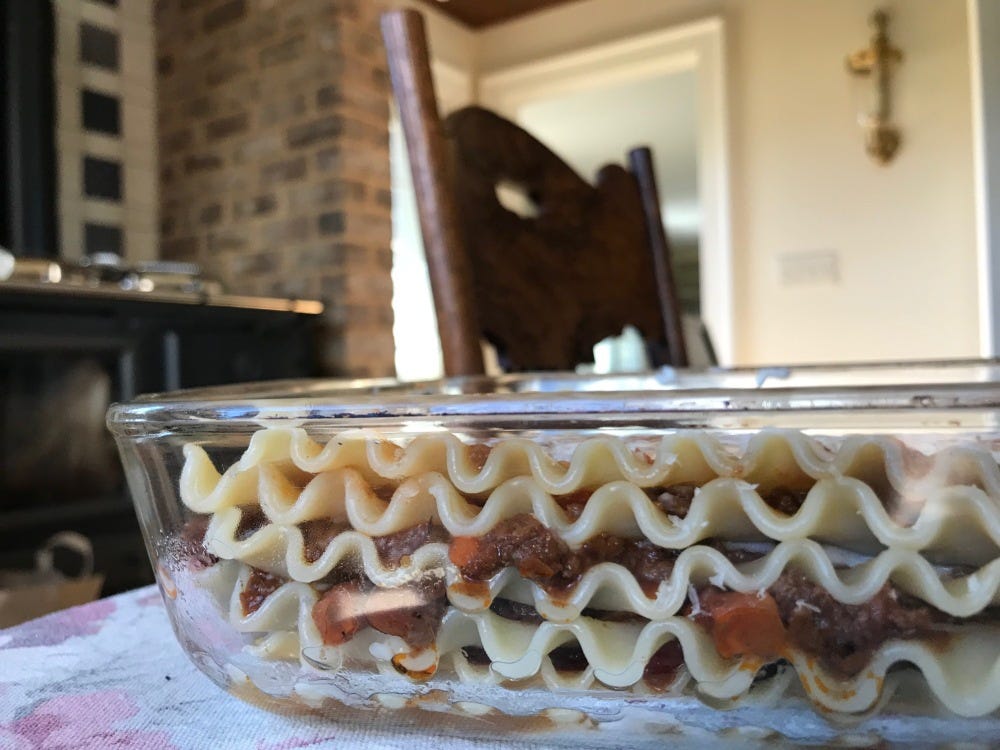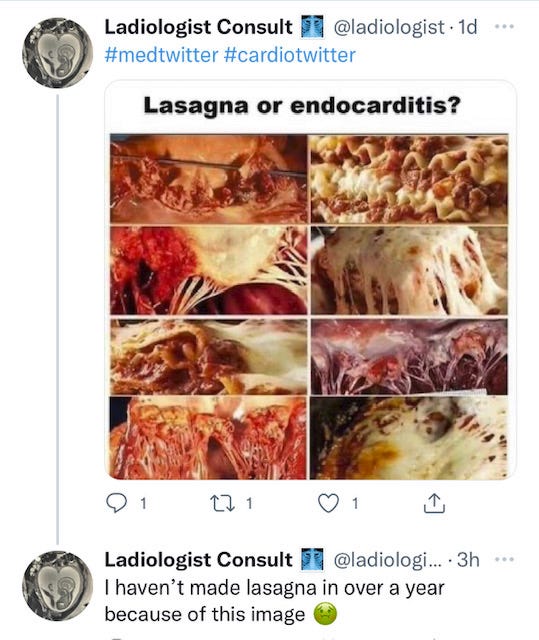Lasagna is a good dish to demonstrate how to think about food. This is a rough guide, albeit incomplete, how to select a recipe, decide how much and how frequently to eat a dish.1
Complexity of Preparation
I have never lived in Italy nor had any exposure to home Italian cooking. Yet as someone who cooks, I look at the number of steps required to make lasagna
making dough for pasta sheets
rolling pasta sheets
cooking meat sauce
cooking milk sauce
grating cheese.
Based on my imagination grounded in experience of how much time and effort all of this takes, I classify it as a very special, holiday dish. As a rule of thumb, complex multi-step dishes should be reserved for rare feasts. Traditionally those would be Easter, Christmas, New Year’s or such. This is not an eat-every-weekend dish. This is definitely not an eat-every-day dish. It is a once a year or once in several years delicacy.
The sheer magnitude of production of this dish also indicates that it was probably a communal, not individual effort to make it. It used to be obvious, but now we must say it - it was enjoyed communally, not alone.
Richness of Ingredients
There are many recipes of lasagna out there. The main components are meat sauce, milk sauce, and cheese. If you know anything about living on a subsistence farm, which is how most people lived for hundreds of years, relying on what food they can produce for themselves, you would see that all the ingredients – meat, milk, and cheese – are scarce, very flavorful animal products that fill you up for a long time.2 You would have a very limited amount of all of the above on a farm. Adding all three into one dish is a luxury of unreachable proportion for the majority of population. It is also frivolous to combine three nutritious ingredients in one dish. You would most likely use one or the other sparingly in an every day bland dish to flavor it and to make it more filling. Unless it is a huge celebration.
Taking all of this into consideration, hopefully, you will suspect that a recipe that has ricotta, mozzarella, and Parmesan cheeses is a cultural abomination and abnormality. Ragu bolognese that has several kinds of meat, pancetta, milk or even (cream!), and olive oil to top all of that makes no sense. Adding extra fat if you are cooking with extremely lean meat would make sense to moisten the meat. If you know that beef at your disposal is of poor quality and may be tasteless, adding a little bit of any pork products would flavor it tremendously. Otherwise, adding loads of multiple fats signals the fall of the Roman Empire. It is expensive, not practical, logically inappropriate, and ultimately, sickening.
Don’t forget that we also will have a butter and milk based bechamel sauce and a sprinkle of Parmesan. You definitely want to go leaner in your meat sauce. Butter, cream, cheese, animal fats, and oil delight taste buds. In the right proportion. Add too much, and your mouth will be coated with grease, stomach will feel heavy after the meal. Your meal is a matter of pleasure, not torture.
Putting it all together
Now, there are recipes that call for liberal use of the meat sauce. How likely would it be to have loads of scarce and expensive meat sauce? Not very. Thus it would make sense that you would be adding a fairly translucent amount of meat sauce and stretching it to cover the pasta sheets. Since lasagna usually has several layers, you will be seeing some bare spots between your sparsely spread meat sauce on each layer of lasagna. You will not feel the dish lacks anything because there are multiple layers of pasta along with meat and milk sauces.
How much to eat?
If you are contemplating a dish that is prepared from scarce, filling, highly nutritious expensive ingredients that requires a multi-step preparation, you should be having a fairly small sample, a morsel of the dish. The dish will serve as a compliment to other cheaper, more readily available dishes that are served in larger quantities. I call them fillers. The fillers are usually vegetable or grain dishes.
P.S. After I wrote my article, I googled “how frequently Italians eat lasagna” and found a Washington post article The Americanization of Lasagna by Candy Sagon. The author confirmed my hypothesis as guided by my general way of trying to make sense of an unknown through the ambiguous and imprecise ways familiar to me.
Poor, pitiful lasagna. What the heck happened when you got to America? In Italy, you were such a stud. Well-dressed, lots of attention to quality and detail, the star attraction at holiday feasts like Christmas, Easter, even weddings. Cooks would slave over you for hours. You were really something special.
…
Lasagna, in Italy at least, has never been an everyday dish. Those delicate sheets of fresh egg pasta, the complex sauces and ingredients for the filling–it better be a momentous occasion to be worth all that work.
…
Don’t overload your lasagna with too many ingredients. Choose one seasonal vegetable or one meat as the theme; add a sauce and a little cheese. Keep it simple. Keep the layers thin. And don’t forget that you should be able to taste the pasta. It’s not just there to be a shelf for a load of filling.
I highly recommend you read the article to get a sense how a dish fits into a culture of local food at a very certain time. This type of analysis and understanding is sorely missing from cookbooks. When you read the article, pay attention to the circumstances of transformation of Italian lasagna into the abomination it became in America. This is a story of how poverty, mentality of newly acquired affluence, abandonment of tradition, but ultimately, money worship at its core lead to ruin.
Discern what truth is and stay grounded in tradition.
Lasagna has nothing to do with calories or endocarditis. Like all serious matters, lasagna is a question that is concerned with Truth. Its only connection with matters of the heart is through pleasure that you receive by healing yourself of ignorance. Ibn Taymiyyah, an eminent top cardiologist, authored an authoritative text “Diseases of the Heart” which summed up centuries of scientific study. “There is in the body a piece of flesh, if it is sound then the whole body will be sound, but if it is corrupt, the the body will be corrupt. It is the heart!” “A person’s heart can become defective and weak if the knowledge and the intent is corrupt. Corruption can lead to anger and misguidance. There are bad illnesses. There cure is guidance that is based on good knowledge. Every person must seek the truth and must follow it.”
What you see in the image below is not lasagna. It is a dis-Grace. It is an affront to God that will, without any reasonable doubt, deprive you of God's unmerited favor, love, or help should you persist in ignorance.
For starters, you do not need to know the minute details. General imagination is enough. To get your imagination going, watch PBS series Frontier Houseabout three modern-day families homesteading as 1880’s pioneers in Montana. Not Italy, but it will do. If you are Italian, I would recommend you look for descriptions of living in the parts of Italy where your family came from - memoires, research, etc. If you are not from Italy, you can apply the same excercise to understand culinary tradition of the people that you came from and belong to.
Tangentially related to this subject is the Patience Gray, author of the cookbook Honey from a Weed, who lived in a remote area of Puglia, Italy. She lived without electricity, modern plumbing, or a telephone, grew much of her own food, and gathered and ate wild plants alongside her neighbors in this economically impoverished region. She was fond of saying that she wrote only for herself and her friends (notable that Ivan Illich wanted to be known as a friend). Adam Freedman wrote Ms.Gray’s biography Fasting and Feasting: The Life of Visionary Food Writer Patience Gray.




